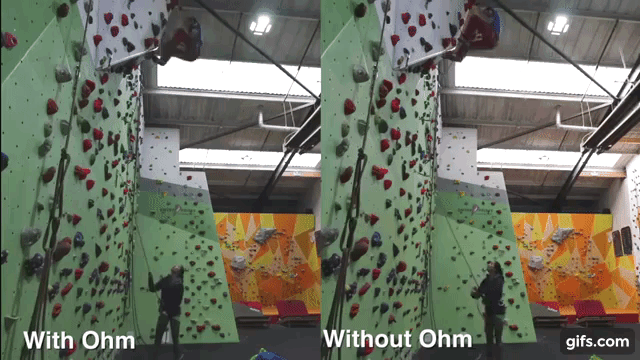Avoiding a "ding-dong" when lead belaying in the gym?
I sometimes climb in the gym with a partner who outweighs me by about 50%. When he's leading and falls from above his protection, I can get pulled up to the first clip. If he's not very far up, this could lead to the dreaded "ding-dong" effect, where I get pulled up and collide with him as he falls.
What effective strategies are there for preventing this? I can try to stand out of his line of fall, but that won't help if I'm simply levitated directly up to the first quickdraw on the wall.
Sometimes when I'm climbing a route in the gym, and I feel confident of the first few clips, I start by clipping a quickdraw that's off to the side, then skip a clip, then clip into the third clip on my actual route. (I skip the second clip because I don't want the rope to go around a sharp corner, which would give a lot of rope drag.) Doing this eliminates the possibility of a ding-dong, at the expense of possibly having a ground fall before I reach the third clip. But this is not something I would ask a climber to do for me when I'm on belay.
This post was sourced from https://outdoors.stackexchange.com/q/8926. It is licensed under CC BY-SA 3.0.
4 answers
Without some kind of ground anchor, you'll have to adapt your belay setup.
First of all, the belayer doesn't have much choice about where to stand. Stand as close as you can to the first clipped draw, or you'll experience the dreaded smacked-into-the-wall-got-knocked-out-and-dropped-my-partner-effect.
Second, a 50% difference isn't huge - lot's of male-female climbing couples handle this. I have hoisted my belayer off the ground before, but we didn't smash into each other violently, just a gentle bump.
Lastly, friction is your friend here. A little bit of a zig-zag in the rope near the bottom should prevent too much rope movement when the leader falls. If the belayer is careful, he/she should be able to keep the rope loose enough to slide through the zig-zag when unweighted. Avoid this up high, of course, as the weight of the rope will create lots of drag.
This post was sourced from https://outdoors.stackexchange.com/a/8929. It is licensed under CC BY-SA 3.0.
0 comment threads
I have seen this managed by having a runner on a low mounted hanger on the a joining climb. The resulting zigzag creates significant friction when the rope is loaded.
An other way to manage this is to give the lead a dynamic belay in a fall - allowing a foot or so of rope to run though the belay, rather than just locking him off. Takes a bit of practice, but is actually something good to know if you ever plan to venture onto trad or alpine routes, or climb sport routes with dodgy bolts.
This post was sourced from https://outdoors.stackexchange.com/a/8931. It is licensed under CC BY-SA 3.0.
0 comment threads
The simplest and most straightforward solution would be to connect yourself to a ground anchor.
If you decide to do this while belaying a lead climber, you might want to let the rope slide a little when they fall, because you will lose the ability to provide a soft-catch by offsetting your body-weight.
This post was sourced from https://outdoors.stackexchange.com/a/8927. It is licensed under CC BY-SA 3.0.
0 comment threads
There are devices exactly for this scenario.
For example Edeldrid has the "Ohm Assisted Braking Device" in their product range:
https://www.rei.com/product/117728/edelrid-ohm-assisted-braking-device
Great for indoor and outdoor use, the Edelrid Ohm Assisted Braking device increases the amount of rope friction so that a lighter-weight belayer can hold a heavier lead climber without difficulty.
It clips to the first bolt like a normal quickdraw, but adds friction in the event of a fall so that the lighter climber doesn't get pulled up so high and the climber doesn't fall as far.
https://www.youtube.com/watch?v=SRnN2tmItqQ
This post was sourced from https://outdoors.stackexchange.com/a/21562. It is licensed under CC BY-SA 4.0.






















0 comment threads